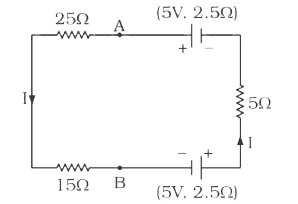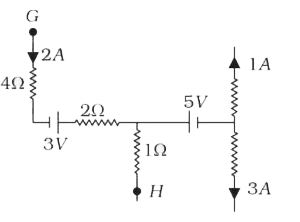In the circuit shown, the potential difference between A and B VAandVB is equal to_______V.

KVLa→b→c→d→a
I0.5+2.5+5+2.5+25)=5+5
I=105=15A
KVLA→a→b→B
VA−I(25)−I(5)=VB
VA−VB=I(40)=15×40VA−VB=8 volt

Topper's Solved these Questions
- DC CIRCUITBOOK - VMC MODULES ENGLISHCHAPTER - DC CIRCUITEXERCISE - LEVEL-2 DAILY TUTORIAL SHEET-1
10 Videos
- DC CIRCUITBOOK - VMC MODULES ENGLISHCHAPTER - DC CIRCUITEXERCISE - LEVEL-2 DAILY TUTORIAL SHEET-2
10 Videos
- DC CIRCUITBOOK - VMC MODULES ENGLISHCHAPTER - DC CIRCUITEXERCISE - LEVEL-1 DAILY TUTORIAL SHEET-4
15 Videos
- CURRENT ELECTRICITYBOOK - VMC MODULES ENGLISHCHAPTER - CURRENT ELECTRICITYEXERCISE - IN-CHAPTER EXERCISE-F
10 Videos
- DYNAMICS OF A PARTICLEBOOK - VMC MODULES ENGLISHCHAPTER - DYNAMICS OF A PARTICLEEXERCISE - JEE Advance (Archive) Level - II (SINGLE OPTION CORRECT TYPE )
31 Videos
Similar Questions
In the circuit shown, the potential difference between A and B is .

View SolutionIn the circuit shown, the potential difference between the points G and H, VG−VH is equal to _________ V.

View SolutionIn the circuit shown, the potential differences, V1 ( between A and B ) and V2 ( between C and D ), are

View SolutionIn the circuit shown, what is the potential different VPQ ?

View SolutionIn the circuit shown, what is the potential difference VPQ in volts ?

View SolutionThe potential difference between the points A and B in the circuit shown is 16 V, Which is/are the correct statement(s) out of the following?

View SolutionThe following figure shows a part of a circuit,the potential difference between C and B(VC−VB) is

View SolutionAt steady state, the potential difference between points C and D in the circuit shown is equal to ________ V.

View Solution
For given circuit potential difference VAB is
View Solution
In the part of the circuit shown in the figure, the potential difference between points VA−VB=16V. The current passing through the 2Ω resistance will be
View Solution
